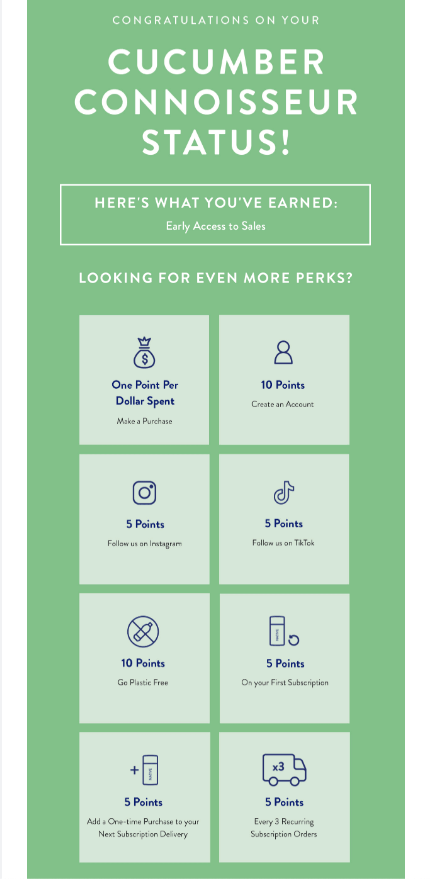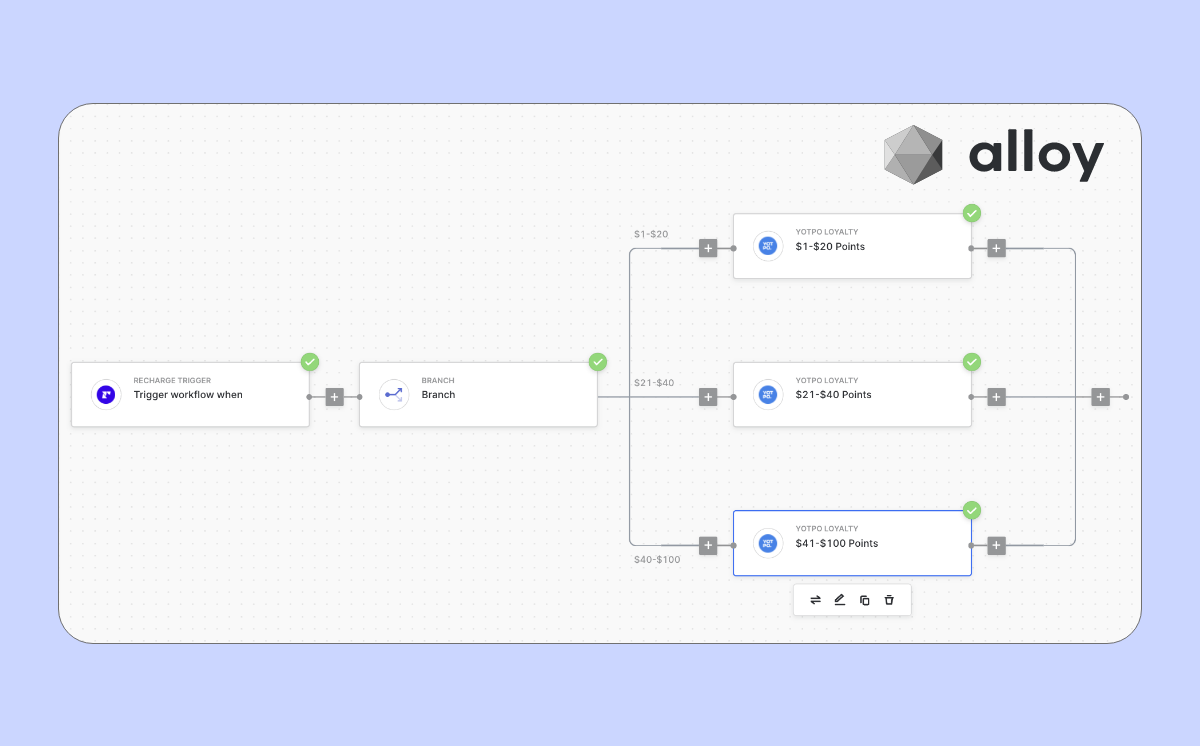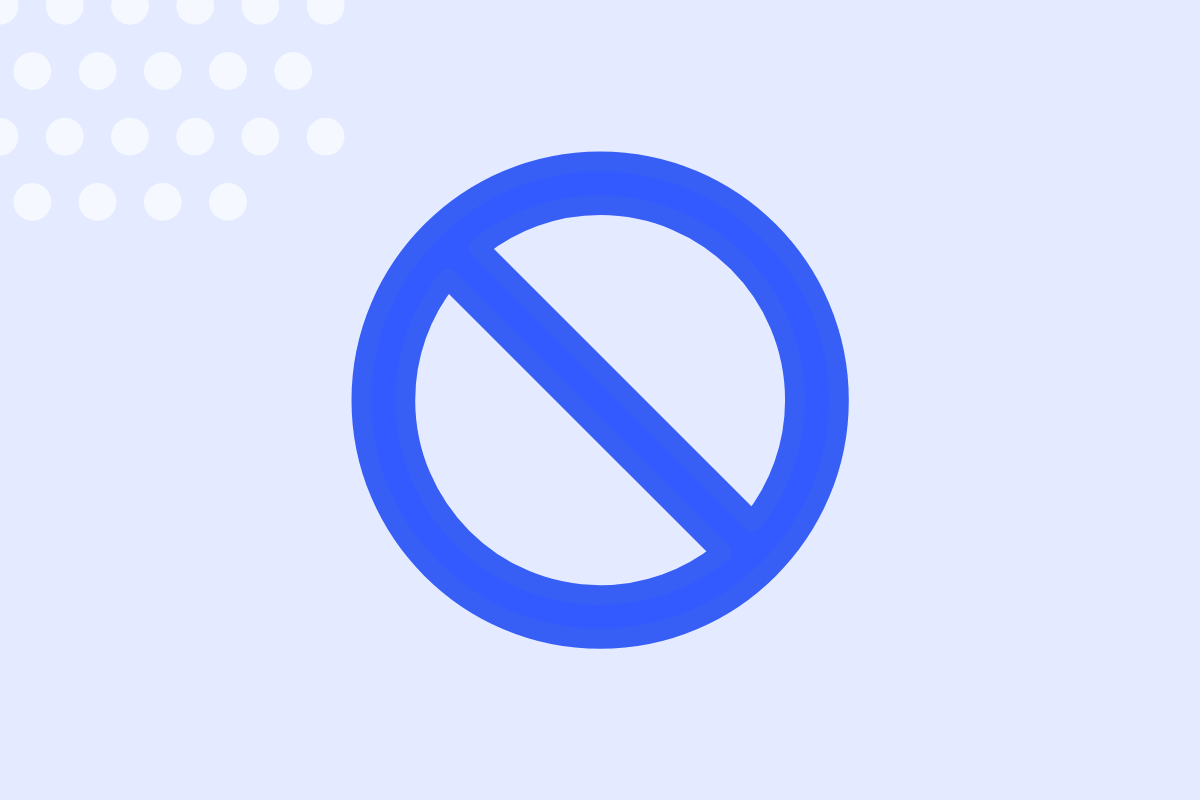Online vendors are constantly told that eCommerce email marketing is the most powerful tool in their toolkit to drive sales.
But what does successful email marketing really look like? 🤔
The truth is, any eCommerce email marketing strategy worth its salt can engage customers and personalize communication while staying focused on the most important goal: more sales. But a strategy like this takes work. A brand must know their customers and what they want out of communication, and it doesn't hurt to have software that will automate the process so the right emails hit customer's inboxes.
In this blog post, we'll look at the 10 best types of email marketing, from abandoned cart reminders to personalized recommendations and newsletters, to bring your customers to the yard.
Ready to put more money in your brand's pocket? Let's go! 👇
1. Welcome emails
Welcome emails introduce your brand and tell the customer what to expect from your messages.
These emails usually tell a story about your brand, touch on any goals and missions you have, and sometimes include a cheeky discount to encourage purchases. Another reason welcome messages should be a staple in any eCommerce email marketing strategy, according to stats, they have some of the highest open rate, delivery rate, and click-through rate of any campaign.
Welcome emails are also very good at bringing in the $$$. If you send an automated welcome email series, it can generate 3x more transactions and revenue compared to regular promotional emails.
There are some best practices you should follow when firing off a welcome email:
- Send it ASAP. New subscribers don't want to wait to hear from you. Studies show 74% expect a welcome email to land in their inbox immediately after signing up to your list.
- Segment where you can. Personalize every email, starting with your first hello. Use tags to pull in any information you collect at sign up and create segments to hyper-personalize your welcome email.
- Sweeten the deal. Sneak in an exclusive discount or incentive in your welcome email to keep your brand at top of mind.
Here's how it's done 👇
How Supergoop! welcomes new subscribers
Supergoop! is a skincare brand that sells sunscreen and has a super loyal customer following.
Every new subscriber gets a message in their inbox, but it ain't no generic hello. The new subscriber gets a discount code (never a bad thing!), and there is a personal welcome by the CEO, who explains what to expect from Supergloop! emails. Here's an example:

What we ❤️ about this welcome email: Interestingly, this welcome email isn't heavy on the product push. Instead, it sets expectations that the brand hopes to be around for the long-haul and ignite change in the customer's daily routine. It puts a face to the brand and tells the subscriber they're not just a customer, they are part of the Supergloop! movement. It's a bold way to start building trust with customers from day one.
2. Abandoned cart emails
Abandoned cart emails have a single goal: to get customers back to the checkout after they left items there without buying them.
These emails are one of the most direct ways for eCommerce brands to increase sales. They remind them about what they've left behind and usually include a bold call-to-action that links the customer straight to their abandoned cart.
Some tips to remember when you send abandoned cart emails include:
- A strong reminder. Don't just include text to remind the shopper what they've left in their cart. Use images, price tags and branding to grab their attention and trigger their memory.
- Offer an incentive. We're talkin' free shipping, access to your VIP rewards or a one-off discount code. At this point, you don't have much to lose, so try and sweeten the deal.
- Sprinkle in some FOMO. Create urgency and tell the customer that the items they left behind are in demand. Add a limited-stock warning or time-limited offer to get the message across.
How Birchbox does abandoned cart emails
Although Birchbox has over 1 million subscribers, it still needs to boost sales and win back customers who have abandoned their carts. It does it with automated abandoned cart recovery message that acts doubles as a cross-sell email:

What we ❤️ about this abandoned cart email: Birchbox has a quirky take on abandoned cart emails. It takes the items the customer left behind and uses them to suggest similar products they might also like, which are backed up by positive customer reviews. It's a super smart way to boost sales using cross-sells.
//[inject:ad-personalized-email]
3. Product Launch emails
These emails are a crucial part of any feature or product launch and give your subscribers a first look at what's new.
Not only do product launch emails help drive traffic to your store and build hype, they can also act as a way to lock in revenue through presale deals. If you want to include email in a product launch strategy, make sure to get the basics right:
- Grab their attention. Always include an eye-catching image (or two) of the new product/feature and some supporting information.
- Don't forget the CTAs. If you launch more than one product at a time, include separate CTAs for each one so the customer lands on the right page on your website.
- Tie it back to your branding. Don't be afraid to inject your brand's personality into product launches. It's an exciting time, so communicate that with some fun images or headlines to draw the customer in.
Here's how Béis does it 👇
How Béis launches products over email
Béis' product launch emails are exactly what you would expect from its brand: they are fun, eye-catching and highlight the best bits of each new product.

What we ❤️ about this product launch email: Béis haven't been afraid to tap into their customer's language. With engaging colors, action shots and stunning product images, the brand turned a product launch into a fun invitation for customers to take a closer look at the new items.
4. Re-engagement emails
Re-engagement emails help you win customers back.
Picture this: your brand snapped up a bunch of new customers over the holiday season. Although most of them are still visiting your website, they haven't purchased anything in a while. Re-engagement emails offer incentives, like a unique discount code or exclusive sale, to get them back to the checkout.
As these customers aren't 100% engaged with your brand, certain tactics can help:
- Make the subject line count. Re-engagement emails can only make an impact if your customers open them. Use a subject line that grabs their attention and is intriguing enough that they need to know more.
- Personalize, personalize, personalize. What did the customer last buy on your site? Have you launched a product recently that is similar to items they've purchased in the past? Use any data you have on the customer to personalize your re-engagement message.
Here's an example of a re-engagement email that ticks all the boxes 👇
How Thread re-engages past customers with a simple question
Thread is an online styling service that helps people find the perfect clothes.
However, some customers use the service one or twice before going cold. Thread tries to win them back with a re-engagement email that mentions the customer by name and then simply asks… "has your style changed?"

What we ❤️ about this re-engagement email: It reminds the customer why they used Thread in the first place: to sharpen up their style. By asking for the customer to re-engage by considering their style preferences, Thread pulls customers back to their website without asking them to buy anything upfront. That comes later, when the customer realizes they may need to update their wardrobe!
5. Newsletter emails
Email newsletters are one of the best ways to build trust with customers.
Regular newsletters keep customers in the loop, educate them about products they love, and give brands a space to talk about any causes they care about. The main goal is to keep subscribers engaged with your brand so if they need a product you stock, you are at the top of their mind.
Newsletter emails take work to be a success, so brands should always:
- Add value. Newsletters are valuable real estate in your customer's inbox. Only include stories or updates that they will care about.
- Make newsletters engaging. Don't be afraid to include multiple images or videos to break up any chunks of text to make the email pop.
- Educate where you can. Provide valuable and relevant content, such as tips, social activism campaigns or upcoming product launches, to keep subscribers interested in what you have to say.
How Heyday builds trust with customers using newsletters
Heyday is a niche skincare brand that aims to change how people tackle their daily beauty routines.
So it's no surprise its regular newsletters are super helpful and include everything from product updates to step-by-step skincare guides:

What we ❤️ about this newsletter email: It's not just plugging products. It highlights real-life scenarios a customer may have battled (like dry skin or puffiness) and suggests how they can overcome it. Yes, the email includes product CTAs, but there are also a bunch of in-depth guides on the store's blog to help customers deal with any skin issues. Heyday isn't ust interested in sales, they want their customers to live their best skincare lives—and it shows!
6. Loyalty Program emails
Brand advocates can become a powerful force to drive sales for your eCommerce store.
A dedicated loyalty program email can encourage customers to turn into repeat buyers and (hopefully) tell their friends and family how much they love your products. A solid loyalty program brings the goods and offers members everything from early access to exclusive deals and products to rewards and incentives to make them feel like VIPs.
The best loyalty programs in an email marketing strategy will:
- Treat members like VIPs. Use personalized messages and product offers that reflect the customer's buying history.
- Give decent rewards. Don't just slap a 10% discount code on a loyalty program email and hit send. You must offer exclusive promotions or early access to new products that nobody else has access to.
- Make it easy to spread the word. VIPs shouldn't have to jump through hoops to redeem rewards or loyalty points. Make it easy for them with a dedicated login page or custom link they can share with friends to boost loyalty points.
How Native keeps customers loyal
Native is a 100% plant-based skincare range that has its own loyalty program called The Clean Collective.
The program encourages customers to buy products and in return, they're given points every single time they make a purchase. When a customer earns enough points, they unlock exclusive rewards:

What we ❤️ about this loyalty email: Seriously… how fun is this loyalty email? Not only does it reinforce that the customer has unlocked the first "tier" of Native's loyalty program, but it also highlights how they can earn more points. It encourages sales and makes the customer feel special. That's what we call a win-win!
7. Customer feedback emails
Customer feedback can be an eCommerce store's secret weapon.
It tells you what you're doing right (and wrong), and if customers feel comfortable, they can also explain what they would improve. These emails usually ask for a rating and review of a recent purchase, but they can also seek out more general feedback of your store or shopping experiences using multiple-choice surveys.
Although these emails can help identify areas for improvement and build customer loyalty, there are some ground rules to follow:
- Don't ask for too much. Keep the email short and simple. Explain what you would like from the customer and how long it will take.
- Offer an incentive. If you want the customer to fill out a survey or give detailed feedback, offering an incentive or coupon code can help get more responses.
- Actually listen to the feedback. When customers take the time to give you feedback, they expect you to take it on board. Make the most of any feedback and use it as an opportunity to improve your customers' experience.
We absolutely love Cometeer's approach to customer feedback 👇
How Cometeer uses a feedback loop to improve its product
Cometeer is an online coffee supplier that specializes in supplying customers with small-batch roasts.
Look, it's inevitable that subscribers will sometimes cancel their subscription. Cometeer understands this and uses post-churn feedback emails as an opportunity to learn:

What we ❤️ about this feedback email: It radiates positivity and makes the customer feel valued, even after they cancel their subscription. The email makes it clear that Cometeer wants to learn from the customer's departure and see what they can do to improve. Rather than a Cometeer discount code, this customer feedback email offers the customer a generous gift card for filling out a quick survey, so they don't have to resubscribe. It's a great way to prove the only goal of the email is to get feedback and learn!
8. Promotional emails
Promotional emails send customers information about sales, discounts or special offers to boost revenue.
These emails are usually tied to an occasion: think the holidays or the customer's birthday. Because of this, they're time limited and create a sense of urgency so customers get FOMO if they think they're going to miss out.
Like the other emails on our list, promotional emails come with some best practices:
- Segment customers based on preferences. Don't send promotional emails to a customer about a product line they've never shown interest in. If you have a storewide sale, let them know. But if there is a 30% sale on basketball jerseys, when the customer has only ever purchased socks, it's probably not going to land that well.
- Test, test, test. Use multivariate testing to mix up images and call-to-actions to see what works best with your customers.
- Create urgency. New products and sales are a great time to highlight limited stocks and availability. Include countdowns or restrictions on item numbers so customers feel the need to buy sooner rather than later.
Here's how it's done 👇
How Zara uses promotional emails to boost sales
Online clothing giant Zara uses promotional emails to launch new seasonal lines and products.
Not only are the email marketing campaigns personalized and segmented based on the customer's preferences, but they're also filled to the brim with eye-catching images:

What we ❤️ about this promotional email: It's basically a style catalog in the customer's inbox. It promotes several different new product lines while sticking to a specific style and gender. As a result of this segmentation, the email will be customized to the customer's tastes and have a higher chance of boosting sales when it hits their inbox.
9. Transactional emails
Sent in response to a specific trigger event, transactional emails keep customers informed about purchases or any changes to their account information.
These emails usually include anything from order confirmations to shipping notifications, receipts, account creation and password reset emails. While transactional emails aren't the most exciting email on our list, they are an essential part of any marketing strategy as they provide customers with important information about their interactions with your brand.
To really build trust and credibility when you send transactional emails, make sure to:
- Keep it simple. If an email has been triggered by a customer who wants to reset their password, don't confuse them with discount codes or product recommendations. Just send them what they ask for.
- Beef up the security. Always ask the customer if they recognize why they are receiving the email, like an account update or recent order. This helps keep their account safe and stop any unusual behavior.
Here's a simple example 👇
Target uses transactional emails to keep customers in the loop
It's no surprise that Target's customer communication is on point.
If a customer has an online account with the store, they can update details, change preferences and keep track of orders. When they do, it triggers an automated transactional email from Target:

What we ❤️ about this transactional email: It's short and sweet. It confirms the changes the customer has made to their account while asking if everything looks correct. Including a way for the customer to contact Target helps build trust and shows the company wants to keep the customer's information safe and secure.
//[inject:ad-demo]
10. Confirmation emails
The last email on our list, confirmation emails outline details of a recent order and give customers a link to shipping information or a digital receipt.
The confirmation email serves as a thank you message to the customer to show your appreciation for their business. If you send out a confirmation email, make sure it:
- Includes vital information. Always confirm the customer's order number, address, shipping details and your contact information if they need to get in touch.
- Is actually helpful. Always add links to your FAQ page and return information so the customer can answer their own questions before reaching out to customer support. It saves you both time!
Here's one of the best confirmation emails we've seen so far 👇
How Crocs covers all bases with a confirmation email
This example from Crocs is a masterclass in how to get confirmation emails right.
Shipping information? Covered. Payment summary and billing information? Covered. Return details just in case the customer isn't 100% happy? It's in there.

What we ❤️ about this confirmation email: It has everything and covers all bases so there is no confusion about the customer's order. The returns barcode is a genius move as it encourages the customer to take it back to the store instead of shipping it back (which saves on shipping costs for the Crocs!)
How to send emails with eCommerce automation software
Every email on this list is a way to boost sales with customers, but if you don't have the right tools, it's very hard for campaigns to land. While an eCommerce business can manually send out emails like newsletters, keeping on top of confirmation emails and loyalty programs is impossible without the right software.
That's why eCommerce automation software is worth its weight in gold.
This software is designed to automate everything from email triggers to segmentation, personalization and important order information. By sending emails at optimized times with the right information, brands can build a strong customer relationship and most importantly—boost sales.
The best part about an eCommerce automation software like Sendlane is it's ready to use, right out-of-the-box. Thanks to pre-built automation sequences, vendors can set up email marketing campaigns and increase revenue without a complex learning curve.
Want to try Sendlane for yourself? Sign up for our 60-day free trial here—no credit card needed!

%20(1).png)




%20(1).png)
.jpg)


.jpg)
.jpg)


.jpg)





.png)



.png)





.png)


.png)

.png)
.png)

.png)
.png)

.png)

.png)


.png)
.png)
%20(1).png)
.png)









.png)











.png)
.png)

%20(1).png)

%20(1).png)



.png)


























.png)











































.jpeg)



.png)



























.png)



.png)

.png)

.png)
.jpeg)


.png)













.png)

.png)










.png)












.png)






































.png)



.png)

.png)

.png)
.png)

.png)
.png)

.png)

.png)

.png)




.png)




















